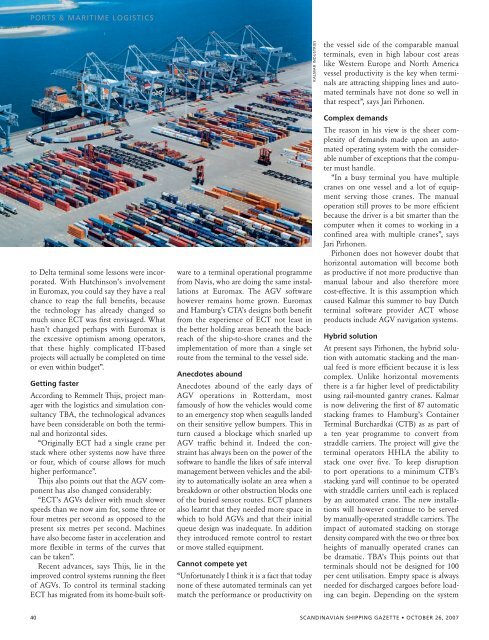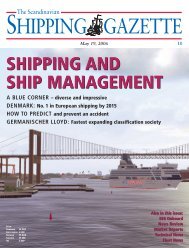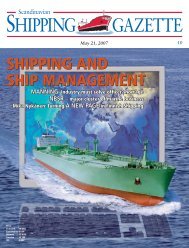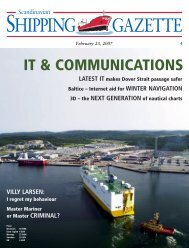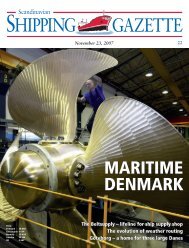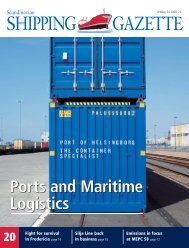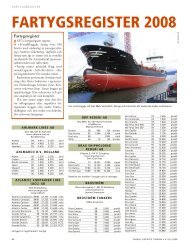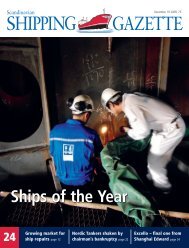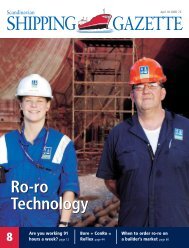SSG No 20 - Shipgaz
SSG No 20 - Shipgaz
SSG No 20 - Shipgaz
Create successful ePaper yourself
Turn your PDF publications into a flip-book with our unique Google optimized e-Paper software.
POrts & maritime lOGistiCs<br />
to Delta terminal some lessons were incorporated.<br />
With Hutchinson’s involvement<br />
in Euromax, you could say they have a real<br />
chance to reap the full benefits, because<br />
the technology has already changed so<br />
much since ECT was first envisaged. What<br />
hasn’t changed perhaps with Euromax is<br />
the excessive optimism among operators,<br />
that these highly complicated IT-based<br />
projects will actually be completed on time<br />
or even within budget”.<br />
Getting faster<br />
According to Remmelt Thijs, project manager<br />
with the logistics and simulation consultancy<br />
TBA, the technological advances<br />
have been considerable on both the terminal<br />
and horizontal sides.<br />
“Originally ECT had a single crane per<br />
stack where other systems now have three<br />
or four, which of course allows for much<br />
higher performance”.<br />
Thijs also points out that the AGV component<br />
has also changed considerably:<br />
“ECT’s AGVs deliver with much slower<br />
speeds than we now aim for, some three or<br />
four metres per second as opposed to the<br />
present six metres per second. Machines<br />
have also become faster in acceleration and<br />
more flexible in terms of the curves that<br />
can be taken”.<br />
Recent advances, says Thijs, lie in the<br />
improved control systems running the fleet<br />
of AGVs. To control its terminal stacking<br />
ECT has migrated from its home-built soft-<br />
ware to a terminal operational programme<br />
from Navis, who are doing the same installations<br />
at Euromax. The AGV software<br />
however remains home grown. Euromax<br />
and Hamburg’s CTA’s designs both benefit<br />
from the experience of ECT not least in<br />
the better holding areas beneath the backreach<br />
of the ship-to-shore cranes and the<br />
implementation of more than a single set<br />
route from the terminal to the vessel side.<br />
Anecdotes abound<br />
Anecdotes abound of the early days of<br />
AGV operations in Rotterdam, most<br />
famously of how the vehicles would come<br />
to an emergency stop when seagulls landed<br />
on their sensitive yellow bumpers. This in<br />
turn caused a blockage which snarled up<br />
AGV traffic behind it. Indeed the constraint<br />
has always been on the power of the<br />
software to handle the likes of safe interval<br />
management between vehicles and the ability<br />
to automatically isolate an area when a<br />
breakdown or other obstruction blocks one<br />
of the buried sensor routes. ECT planners<br />
also learnt that they needed more space in<br />
which to hold AGVs and that their initial<br />
queue design was inadequate. In addition<br />
they introduced remote control to restart<br />
or move stalled equipment.<br />
Cannot compete yet<br />
“Unfortunately I think it is a fact that today<br />
none of these automated terminals can yet<br />
match the performance or productivity on<br />
kalmar industries<br />
the vessel side of the comparable manual<br />
terminals, even in high labour cost areas<br />
like Western Europe and <strong>No</strong>rth America<br />
vessel productivity is the key when terminals<br />
are attracting shipping lines and automated<br />
terminals have not done so well in<br />
that respect”, says Jari Pirhonen.<br />
Complex demands<br />
The reason in his view is the sheer complexity<br />
of demands made upon an automated<br />
operating system with the considerable<br />
number of exceptions that the computer<br />
must handle.<br />
“In a busy terminal you have multiple<br />
cranes on one vessel and a lot of equipment<br />
serving those cranes. The manual<br />
operation still proves to be more efficient<br />
because the driver is a bit smarter than the<br />
computer when it comes to working in a<br />
confined area with multiple cranes”, says<br />
Jari Pirhonen.<br />
Pirhonen does not however doubt that<br />
horizontal automation will become both<br />
as productive if not more productive than<br />
manual labour and also therefore more<br />
cost-effective. It is this assumption which<br />
caused Kalmar this summer to buy Dutch<br />
terminal software provider ACT whose<br />
products include AGV navigation systems.<br />
Hybrid solution<br />
At present says Pirhonen, the hybrid solution<br />
with automatic stacking and the manual<br />
feed is more efficient because it is less<br />
complex. Unlike horizontal movements<br />
there is a far higher level of predictability<br />
using rail-mounted gantry cranes. Kalmar<br />
is now delivering the first of 87 automatic<br />
stacking frames to Hamburg’s Container<br />
Terminal Burchardkai (CTB) as as part of<br />
a ten year programme to convert from<br />
straddle carriers. The project will give the<br />
terminal operators HHLA the ability to<br />
stack one over five. To keep disruption<br />
to port operations to a minimum CTB’s<br />
stacking yard will continue to be operated<br />
with straddle carriers until each is replaced<br />
by an automated crane. The new installations<br />
will however continue to be served<br />
by manually-operated straddle carriers. The<br />
impact of automated stacking on storage<br />
density compared with the two or three box<br />
heights of manually operated cranes can<br />
be dramatic. TBA’s Thijs points out that<br />
terminals should not be designed for 100<br />
per cent utilisation. Empty space is always<br />
needed for discharged cargoes before loading<br />
can begin. Depending on the system<br />
40 sCandinaVian sHiPPinG GaZette • OCtOBer 26, <strong>20</strong>07


